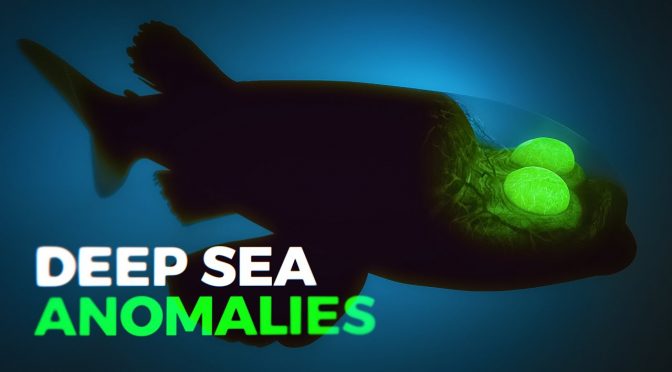Drawing insights from the video “Why Animals Get Creepier the Deeper You Go” by Real Science, this article succinctly explores the intriguing realm of deep-sea creatures. It examines their unique adaptations and the rationale behind their seemingly eerie appearances. The video, embedded within the article, serves as the foundation for a concise yet comprehensive understanding of these deep-sea mysteries.
Contents
- The Mesmerizing World of the Deep Sea
- The Twilight Zone: A World of Red
- The Big Fin Squid: A Deep-Sea Enigma
- The Predatory Tunicate: A Carnivorous Filter Feeder
- The Gulper Eel
- The Anglerfish
- The Pacific Barreleye Fish: A Visionary Predator
- The Tripod Fish: A Sightless Hunter
- The Hadal Snailfish: The Deepest Dweller
- The Human Perception of Deep-Sea Creatures
- The Fascinating Evolution of Ocean Creatures
- The video
- Conclusion
The Mesmerizing World of the Deep Sea
The deep sea, despite its crushing pressure, near-freezing temperatures, and absence of sunlight, is teeming with life. The creatures inhabiting these depths have evolved in ways that can seem alien to us. Some have enormous, piercing eyes, while others have none. Some glow for defense or predation, and some have evolved to become terrifying carnivores. The deeper you go, the more bizarre these creatures appear.
The Twilight Zone: A World of Red
The mesopelagic zone, also known as the Twilight Zone, extends from 200 meters to 1,000 meters below the surface. Here, the first color to disappear is red, due to its long wavelength and low energy. Many creatures in this zone have evolved to be shades of red, rendering them practically invisible at these depths. An example is the vampire squid, which despite its fearsome appearance, feeds on marine snow, a mix of decaying organisms and fecal matter.
The Big Fin Squid: A Deep-Sea Enigma
The big fin squid, a member of the genus Magnapina, is thought to be the deepest occurring squid genus, with sightings as deep as 6,212 meters. Their arms and tentacles can be up to eight meters long and are usually held at right angles, giving them an otherworldly appearance. Little is known about their feeding behavior, but it’s speculated that they might use their long arms to grab edible organisms from the sea floor.
The Predatory Tunicate: A Carnivorous Filter Feeder
In the deep sea, some organisms that are herbivores or filter feeders in shallower parts of the ocean become carnivores. One such creature is the predatory tunicate, a stationary filter feeder that lives at depths from 600 to 1,100 meters. It catches prey by snapping its mouth shut when small invertebrates and crustaceans drift into it.
The Gulper Eel
The gulper eel, found at depths over 1,800 meters, is a startling specimen with a mouth larger than the rest of its body. This adaptation allows it to swallow animals much larger than itself, a crucial advantage in an environment where food is scarce.
The Anglerfish
Perhaps the most infamous among the deep-sea hunters is the anglerfish. They use a bioluminescent lure attached to their heads to attract prey, and their highly flexible jaws and inward-pointing teeth ensure that once they trap their prey, there’s little chance of escape.
The Pacific Barreleye Fish: A Visionary Predator
The Pacific barreleye fish, with its enormous tubular eyes directed upward, can see prey swimming overhead. These eyes are encased inside their head, closed in by a transparent shield. This adaptation allows them to keep their prey in view at all times, even as they snap their body vertically to snatch the food swimming above them.
The Tripod Fish: A Sightless Hunter
In the bathypelagic or abyssopelagic zones, where no sunlight penetrates, some deep-sea creatures forego vision altogether. The tripod fish, for example, balances on the sea floor, waitingfor other creatures to swim by. Their elongated pelvic fins stretch down to the ground, holding them motionless and upright, while they use their pectoral fins like hands to sense the water currents and whatever objects might float their way.
The Hadal Snailfish: The Deepest Dweller
Recently, scientists exploring a marine trench near Japan were stunned to find a fish living 8,336 meters below the surface. This creature, a type of hadal snailfish, is the deepest fish anyone has ever found. Little is known about this ghostly, ethereal fish that thrives in a place named after Hades itself.
The Human Perception of Deep-Sea Creatures
The creatures of the deep sea invoke creepy feelings in us because they are unlike anything we see in our daily lives. Their habitat is so far removed from us that we liken it to the underworld. However, it’s important to remember that these creatures are a vital part of our world and deserve our consideration, care, and protection like any other part of our planet.
The Fascinating Evolution of Ocean Creatures
The evolution of ocean creatures is undeniably fascinating. Every freaky and foreign adaptation excites our imaginations. But some of the most astonishing adaptations on Earth happen right here on land and in our own species. For instance, human sonar allows people without sight to see with sound, and individuals who lost their sight due to damage to their visual cortex can still complete obstacle courses with no knowledge that they even did so.
The video
Conclusion
The deep sea, a realm of darkness and extreme conditions, is home to a myriad of creatures that have evolved in ways that can seem alien to us. From the red-hued vampire squid in the Twilight Zone to the deepest-dwelling hadal snailfish, these creatures have adapted to survive in an environment vastly different from our own. While their appearances may seem eerie to us, each adaptation serves a crucial purpose in their survival.

